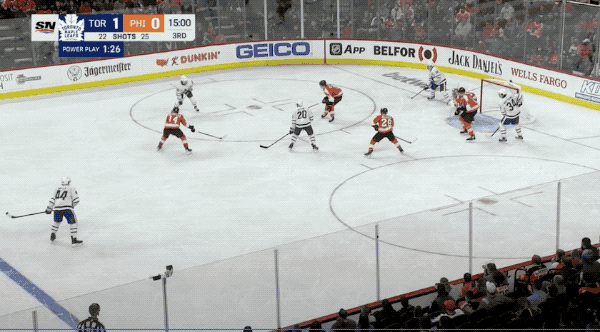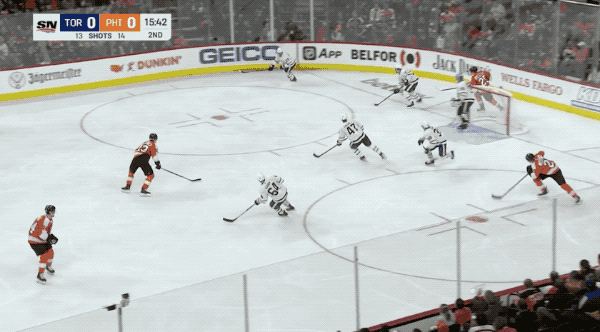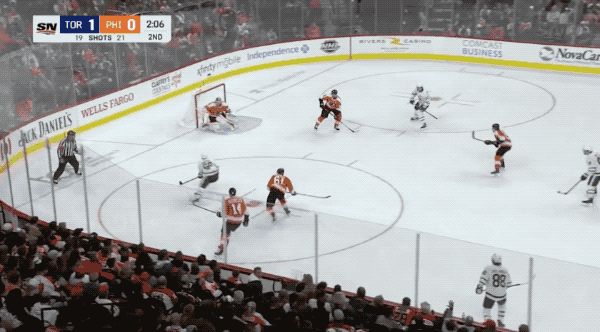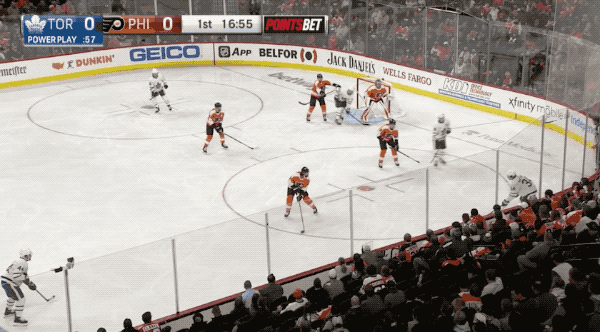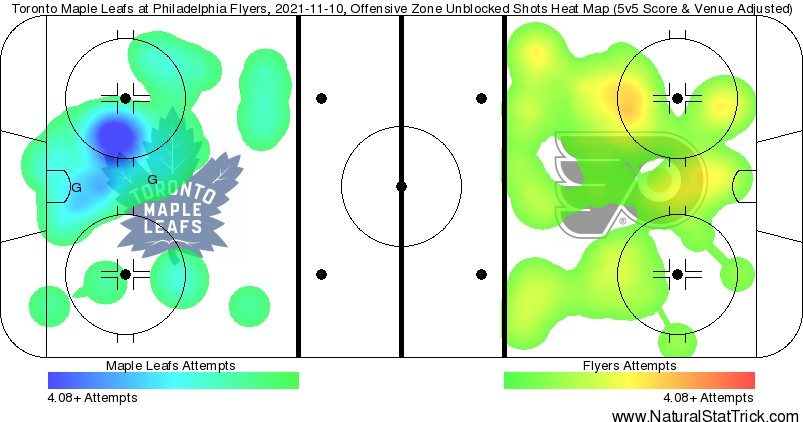Well, that was boring… until it wasn’t!
There weren’t too many scoring chances in this game for either side, but the Leafs were eventually able to break through in the back half of the game and ultimately win the game 3-0.
This was one of those kinds of nights that coaches love and fans hate: low-event, defensive hockey. On the one hand, it’s nice to see Toronto pull through in this style of game, knowing that they’ll definitely run into a few of these challenging nights in the playoffs.
On the other hand, it was a tad concerning to see them fail to generate much off the rush against — let’s face it — not exactly the strongest defensive unit in the NHL. The Flyers have some good forwards up front, but their first, second, and third pairs rank 24th, 26th, and 22nd respectively in Dom Luszczyszyn’s model.
The good news is that Toronto out-chanced Philadelphia at even strength and their power play looked solid even without John Tavares in the lineup. Mitch Marner didn’t exactly “carry his own line” tonight, but I found his movement and positioning on the power play quite intriguing, which we’ll break down in detail later.
For now, let’s focus on the players who made the biggest impact in tonight’s game. It’s time for some Leafs Report Cards!
5 Stars
William Nylander (RW, #88) — He’s been Toronto’s most consistent player all season. Nylander potted two goals tonight, almost picking up a third on a breakaway where he bobbled the puck. His first goal was a bizarre “non-kicking motion”, while his second was more the type of goal you’d expect Nylander to score; beating a goaltender clean from the slot on the power play.
It’s also worth noting how well Nylander was playing at 5v5, using the entire width of the offensive zone to cycle the puck, come up high as the “third defenseman” and attack downhill with speed. This is a key component of Sheldon Keefe’s system, bringing a skilled player high in the zone to work quick little one-twos with defensemen. It helps open up the ice and gives a talented puck-carrier like Nylander room to operate.
He did a great job taking advantage of that open space in this game.
4 Stars
Nick Ritchie (LW, #20) — Let’s throw the man a bone. This was his best game of the season. In fact, I’d argue these might’ve been the best two plays Ritchie has made as a Leaf so far.
Now, it’s a very cushy spot to be playing in the middle of a Nylander-Marner-Matthews triangle on the power play, but that’s still an excellent pass by Ritchie.
The quick-release beforehand also helped show off the main attribute he brings to the table: his goal-scoring ability. He obviously has zero goals on the season — I ran the numbers myself — but he generated a team-high seven chances from the slot in this game. Good things happen when you get shots off from dangerous locations, which is what Ritchie accomplished tonight.
I’d still like to see him throw his weight around more on the forecheck. It’d also be nice if he quit taking his one dumb penalty per week. Sometimes it feels like he’s trying to meet a quota. At the end of the day, though, what you want to see is Ritchie getting his big body to the net and getting chances from in tight.
He did that on Wednesday night, so credit where credit’s due; he played well!
Ondrej Kase (RW, #25) — Of course Ondrej Kase blocked two of his own teammates’ shots in the offensive zone and headed straight to the dressing room. Weird collisions just seem to follow this guy around everywhere he goes. On the plus side, he just keeps getting back up and continues to fight through these painful looking moments.
When he wasn’t lying down on the ice wincing in pain, he was using his speed to get the puck up the ice and make plays. My favourite sequence was Kase beating his man on the breakout, forcing a turnover in the offensive zone, and then immediately making a slot pass to Engvall for a quality chance.
Kase also scored a goal-scorer’s goal in the third period, rifling a one-timer from the slot into the top left corner of the net. It was the kind of goal that should remind you he’s been a top-30 goal scorer in the NHL throughout his career, at least when it comes to 5v5 Goals per 60. That’s a first-line scoring rate!
It pains me to keep repeating this, but I’d love to see what he could do with some linemates who could actually get him the puck.
Timothy Liljegren (RD, #37) — He did a great job jumping up into the play. I mentioned earlier that Toronto didn’t generate as many rush opportunities as you’d like to see against a weak defense core. Well, Liljegren was the exception to that. He was excellent at joining the rush, sometimes even leading the rush in transition.
He almost picked up a goal later in the game, driving to the net and redirecting a saucer pass from Nick Ritchie of all people. Liljegren did have one bad turnover at the offensive blueline that came back the other way, but he was bailed out by Jack Campbell. That was maybe one risk too many for Liljegren, although I love the confidence he’s been playing with lately.
He’s got more swagger with the puck than I’ve ever seen from him in his days with the Marlies. At one point he even broke an opposing player’s ankles by baiting him with a fake wrist shot while walking the line. I’m starting to think Liljegren might be here to stay.
Jack Campbell (G, #36) — It’s hard to criticize a goaltender who literally allowed zero goals on 36 shots. That said, Campbell’s rebound control got a bit sketchy at times. He was obviously able to clean up some of the messes he made, scrambling to recover and make the extra save on those rebound opportunities. In a perfect world, he’d velcro the initial shot and not give up a few mad scrambles in front.
Then again, in a perfect world, he’d allow zero goals against, which is exactly what Campbell did against the Flyers. Maybe I am overthinking this.
Kirill Semyonov (LW, #94) — This guy can play. Even in the preseason, Semyonov was one of the Leafs I came away most impressed with, noticing his ability to make subtle little passes out of tight spots and right onto a teammate’s tape. He also looked great on the penalty kill, forcing turnovers, winning puck races, and skating back hard to break up plays in the neutral zone.
He also put up nine points in nine AHL games with the Marlies, so I wouldn’t be shocked if there’s a bit more offense there than we’ve seen so far at the NHL level. I want to see more of Semyonov, so here’s hoping he gets a few more games to showcase his skillset.
The Rielly-Brodie Pair — This was your typical Morgan Rielly game, jumping up into the play as the fourth forward early and often. At times, it looked like he might’ve pinched a tad too aggressively, but he was able to recover each time with his speed to break up the rush chance coming the other way.
Rielly doesn’t always recover on plays like these, so I think it’s important to praise him for the times he does get back in time.
In contrast, TJ Brodie played one of his smoothest games of the season, very rarely taking any risks with his game. That’s A-okay when you’re partnered with Rielly. In fact, it’s a must. My biggest takeaway from Brodie’s game tonight was that he was looking much more comfortable with the puck on his stick, starting up the breakout with much more confidence than we’d seen earlier in the season.
3 Stars
The Muzzin-Holl Pair — I know a lot of Leafs fans didn’t love Justin Holl‘s game tonight, which I can understand considering some of his weird turnovers, but I also really liked his transition defense in this game. The neutral zone tends to be an under-appreciated aspect of hockey, especially on the defensive side of the puck. There were multiple times Holl stepped up between the blue lines and broke up opposing rushes before they had a chance to develop.
His partner, Jake Muzzin, was also pretty solid in that department, although it was his in-zone defense that I appreciated the most, particularly on the penalty kill. Muzzin is often the last line of defense for Toronto in their own end, blocking passes and shots from dangerous areas. He also chipped in with some offense, picking up a primary assist on Nylander’s soccer goal.
Alex Kerfoot (C, #15) — This is a weird one because most of Kerfoot’s shifts went by without me noticing him, but on two or three of them he’d make a game-breaking play. For example, on a 6v5 due to a delayed penalty, he made two guys miss in the neutral zone and then threaded a saucer pass to Auston Matthews in alone behind the defense. The puck bounced over his stick — because hockey — but that’s an incredible scoring chance created out of nothing.
Kerfoot also picked up an assist on the Kase goal, wheeling around the net with speed before threading the puck to him in the slot for a one-timer. That’s a combination we haven’t seen enough of this season. Both players are speedy and can make crafty plays in transition; we’ve seen it on the penalty kill.
With Kerfoot as a natural passer and Kase as a natural shooter, why not play these two together for a few games and see what happens?
Jason Spezza (C, #19) — The yo-yo-ing of Spezza from the fourth line and up to the second line alongside Kerfoot-Marner in place of Ritchie was a bit weird in this game. To Spezza’s credit, he rolled with the punches and continued to make plays with the puck, finding Kerfoot in the slot at one point.
He also did this.
SPEZZA LOCKED AND LOADED FROM THE ROCKSTAR ZONE! pic.twitter.com/L8WVKe7wUu
— big heatdaddy (@DanyAllstar15) November 11, 2021
Sometimes you just need to unleash your inner Steven Stamkos.
No such thing as a bad-angle shot for Jason Spezza pic.twitter.com/8iX6AUkwNd
— Mark Masters (@markhmasters) October 30, 2021
And sometimes it’s just a shot you’ve been working on a hundred times in practice.
Wayne Simmonds (RW, #24) — Spezza’s linemate (on most shifts) had a decent night, too. He made an impact on the forecheck with his physicality, knocking Rasmus Ristolainen off his feet with a huge hit. Simmonds also had a great chance from in tight on the power play. He’s bound to start scoring at some point with the number of shots he’s been generating from the blue paint.
Auston Matthews (C, #34) — This is about as quiet of a two-point night as Auston Matthews is going to have. This isn’t to say he played poorly, but he wasn’t exactly dynamic with the puck on his stick. He impacted the game in other ways, including defensively by forcing turnovers in the neutral zone and starting rush chances off of those turnovers.
Matthews also had a great backcheck on Ivan Provorov later in the game, showing off some of that extra burst in his skating after slimming down to 205 pounds. He did pick up two assists, one of which was a slick little saucer pass to get Muzzin behind the defense for a 2-on-1. The other was to Ritchie on the power play, which wasn’t as much of a game-breaking play.
I hate that I’m criticizing a two-point night for a star player, but that’s the lofty standard Matthews has set for himself. When he fails to generate individual scoring chances at an absurd rate, it leaves us wanting more.
2 Stars
Mitch Marner (RW, #16) — For years we’ve been asking if Mitch Marner can drive his own line. The answer tends to be “no” when you look at the large sample of evidence, with tonight being no exception at 5v5. The Ritchie-Kerfoot-Marner line did break even in scoring chances, but they got outshot by five. You’d expect more from a $17 million line.
Now, one area of Marner’s game that did really impress me was on the power play. He was clearly making a concerted effort to get himself below the goal-line as a passer.
I love this.
Not that anything materialized on this particular clip, but just the fact that Marner is actively trying to get himself below the goal line is proof that he’s buying into his strengths as a behind-the-net passer. On the Nylander power-play goal, Marner was playing a similar role, just on the other side of the net.
As I’ve mentioned countless times in these report cards, passes from below the goal line lead to a significantly higher shooting percentage. Marner seems to be buying into this philosophy. It’s already led to a Tavares power-play goal the other night, not to mention a Grade-A chance for Ritchie tonight.
I can’t wait to see this aspect of Toronto’s power play continue to develop. It’s a play I’ve wanted to see for a long time, especially with Marner as the passer behind the net.
Pierre Engvall (LW, #47) — I didn’t hate Engvall’s game tonight as much as the average Leafs fan, but I also didn’t love it. He’s a legitimate difference-maker on the penalty kill with his speed and length, especially when he’s playing the drop pass. When he forces a turnover and regains possession at 4v5, he does everything in his power to hold onto the puck for as long as possible, killing precious seconds of the power play.
At even strength, I can understand why Keefe gets frustrated with Engvall for not being a better version of himself. Shot selection, not throwing his weight around, refusing to drop his shoulder and plow his way to the net — all of these things drive us nuts.
When you look at his results, though, he’s produced at a third-line rate throughout his career and doesn’t give up very many chances when he’s on the ice. For all the frustrations we have about the player he isn’t, I think sometimes we need to sit back and give him credit for the player he actually is: an effective one at the NHL level.
This has been your, “Please Do Not Waive Pierre Engvall,” public service announcement. We now return to original programming.
Rasmus Sandin (LD, #38) — I usually love Sandin’s game; his passing; his vision; his creativity. I didn’t love Sandin’s game tonight. He just didn’t seem to be making enough plays with the puck to dictate play, and when he isn’t capitalizing on his skill advantage, he’s getting beat up in the hard areas of the ice (i.e. below the dots in his own end).
I still think players like Sandin end up on the positive side of the ledger in the aggregate, but tonight was one of those nights where he got physically overpowered and wasn’t able to make up for it with his brilliant puck movement.
Complete A Pass — As you can probably guess by now, I like players who complete passes up the ice, into the offensive zone, and through the slot. These are the players who drive results in the modern game. David Kampf is not one of those players, at least offensively.
He and Michael Bunting both really struggled to make plays with the puck on their stick tonight, often being the last player to touch it before the play died. They’re obviously not paid for their puck skills, but when you’re turning over possessions at the rate they did on Wednesday night, strong defensive play or rat-like behaviour in front of the net isn’t enough to make up for it.
They needed to complete more plays.
Heat Map
Here’s a quick look at where each team’s shots were coming from at even strength, courtesy of Natural Stat Trick.
This was another one of those Quality > Quantity kind of nights for Toronto. They got outshot by Philadelphia, with the Leafs only controlling 45 percent of the shots at even strength, but they had 59 percent of the scoring chances and 57 percent of the expected goals.
As you can see from the heat map above, Toronto did a much better job of penetrating the slot, which is where goals are scored in this sport.
Game Score
Game score is a metric developed by The Athletic’s Dom Luszczyszyn to measure single-game performance. You can read more about it here.
Still not used to seeing Nick Ritchie near the top of these.
Tweets of the Night
Per SportLogiq Leafs enter this game 1st in o-zone possession time per game, Flyers 31st. So, not exactly surprised by the location of the run of play so far, Tavares or not.
— Justin Bourne (@jtbourne) November 11, 2021
I found this stat pretty interesting, in that it was the David vs. Goliath of puck possession. The Keefe Leafs remind me a lot of Pep Guardiola soccer teams (Manchester City currently, Barcelona in years past) in that they prioritize holding onto the puck/ball and waiting for a seam to open up before making the game-breaking pass.
There are pros and cons to this approach. For example:
Have watched the leafs a few times this year and they do not seem particularly fast. Ideally I want to really play on the rush with their talent. I wonder if any of that is tied to the playoff issues. Even with talent it’s hard to break down in-zone defense
— Kevin (@ntrider825) November 11, 2021
Kevin isn’t wrong. These last two seasons are the slowest I can remember the Leafs playing in a long time. There are benefits to a slow buildup: more puck support, a higher completion percentage on passing plays, more zone time with possession.
The downside is you lose those quick-strike opportunities off the rush, which is something you’d typically expect from a team with so much offensive firepower. Time will tell if Toronto can find the right balance between puck possession and counterattacking. One thing’s for sure: Keefe wants them to play faster and get the puck up to their skilled players before opposing defenses have a chance to get set.
It’s much harder to score when the opponent has five skaters behind the puck.
Kase would score so many goals if he played with any forward who could pass him the puck
— J (@Account4hockey) November 11, 2021
David Kampf had zero assists coming into this game.
Kase plays one shift with Kerfoot, scores immediately. Coincidence?

























